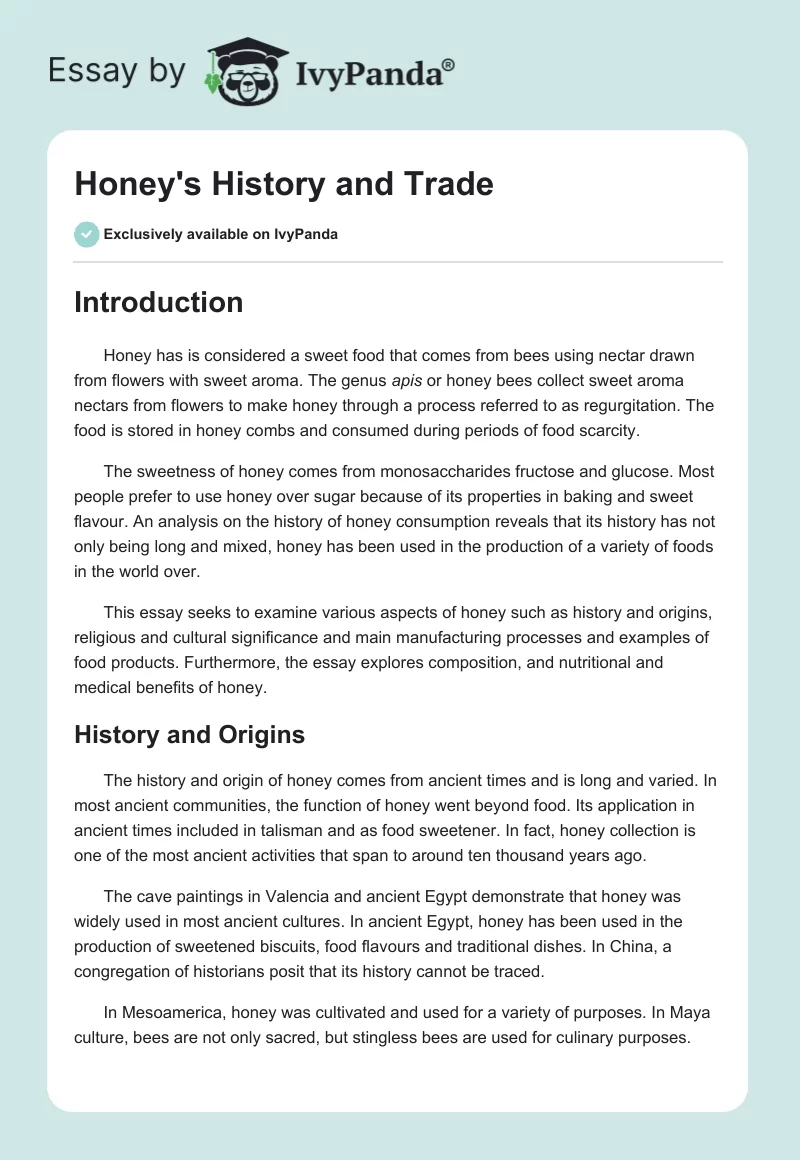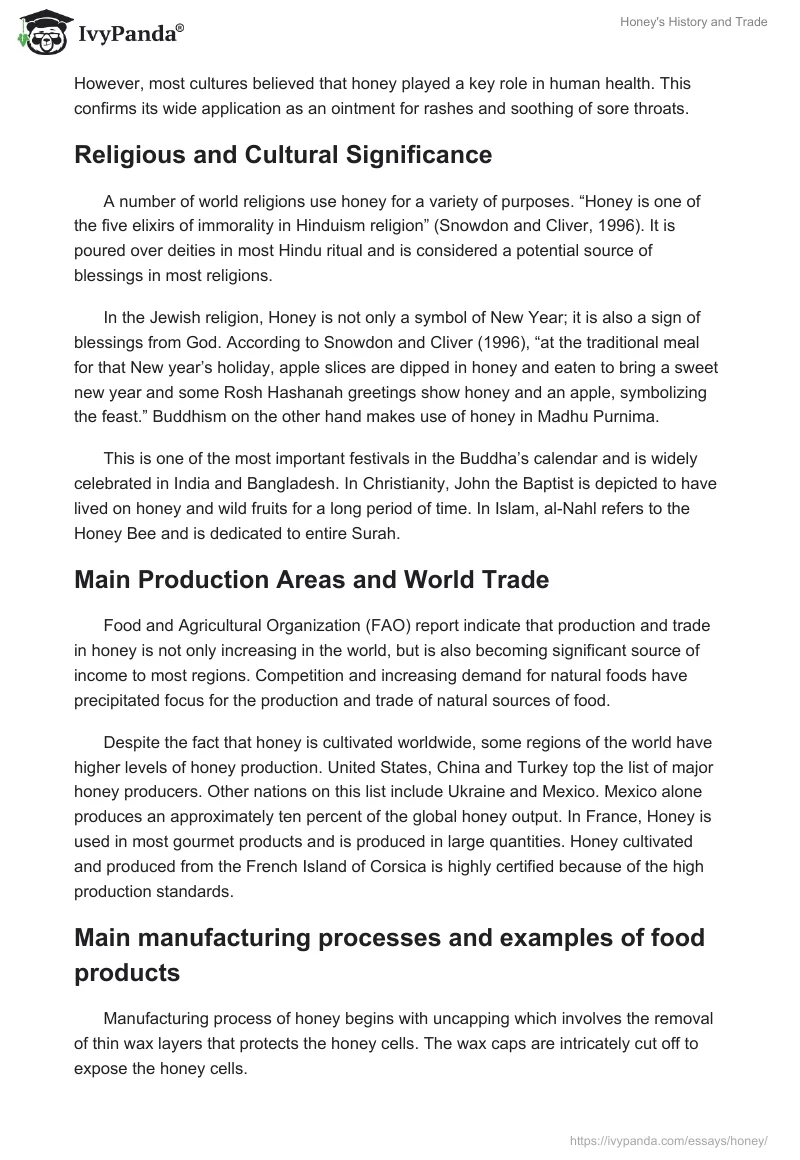Introduction
Honey has is considered a sweet food that comes from bees using nectar drawn from flowers with sweet aroma. The genus apis or honey bees collect sweet aroma nectars from flowers to make honey through a process referred to as regurgitation. The food is stored in honey combs and consumed during periods of food scarcity.
The sweetness of honey comes from monosaccharides fructose and glucose. Most people prefer to use honey over sugar because of its properties in baking and sweet flavour. An analysis on the history of honey consumption reveals that its history has not only being long and mixed, honey has been used in the production of a variety of foods in the world over.
This essay seeks to examine various aspects of honey such as history and origins, religious and cultural significance and main manufacturing processes and examples of food products. Furthermore, the essay explores composition, and nutritional and medical benefits of honey.
History and Origins
The history and origin of honey comes from ancient times and is long and varied. In most ancient communities, the function of honey went beyond food. Its application in ancient times included in talisman and as food sweetener. In fact, honey collection is one of the most ancient activities that span to around ten thousand years ago.
The cave paintings in Valencia and ancient Egypt demonstrate that honey was widely used in most ancient cultures. In ancient Egypt, honey has been used in the production of sweetened biscuits, food flavours and traditional dishes. In China, a congregation of historians posit that its history cannot be traced.
In Mesoamerica, honey was cultivated and used for a variety of purposes. In Maya culture, bees are not only sacred, but stingless bees are used for culinary purposes. However, most cultures believed that honey played a key role in human health. This confirms its wide application as an ointment for rashes and soothing of sore throats.
Religious and Cultural Significance
A number of world religions use honey for a variety of purposes. “Honey is one of the five elixirs of immorality in Hinduism religion” (Snowdon and Cliver, 1996). It is poured over deities in most Hindu ritual and is considered a potential source of blessings in most religions.
In the Jewish religion, Honey is not only a symbol of New Year; it is also a sign of blessings from God. According to Snowdon and Cliver (1996), “at the traditional meal for that New year’s holiday, apple slices are dipped in honey and eaten to bring a sweet new year and some Rosh Hashanah greetings show honey and an apple, symbolizing the feast.” Buddhism on the other hand makes use of honey in Madhu Purnima.
This is one of the most important festivals in the Buddha’s calendar and is widely celebrated in India and Bangladesh. In Christianity, John the Baptist is depicted to have lived on honey and wild fruits for a long period of time. In Islam, al-Nahl refers to the Honey Bee and is dedicated to entire Surah.
Main Production Areas and World Trade
Food and Agricultural Organization (FAO) report indicate that production and trade in honey is not only increasing in the world, but is also becoming significant source of income to most regions. Competition and increasing demand for natural foods have precipitated focus for the production and trade of natural sources of food.
Despite the fact that honey is cultivated worldwide, some regions of the world have higher levels of honey production. United States, China and Turkey top the list of major honey producers. Other nations on this list include Ukraine and Mexico. Mexico alone produces an approximately ten percent of the global honey output. In France, Honey is used in most gourmet products and is produced in large quantities. Honey cultivated and produced from the French Island of Corsica is highly certified because of the high production standards.
Main manufacturing processes and examples of food products
Manufacturing process of honey begins with uncapping which involves the removal of thin wax layers that protects the honey cells. The wax caps are intricately cut off to expose the honey cells.
According to Subramanian, Hebbar and Rastogi (2007), “honey frame processing proceeds, after a manual 2 frame model to motorized units extracting more than 12 deep supers at a time and commonly 24 to 72 frame radial extractors are used for commercial enterprises.”
The whole process must be executed at temperatures below thirty degrees Celsius to avoid over-heating the honey. The honey is extracted and cleaned or purified to remove impurities. Despite the fact that different companies employ different approaches in honey extraction, the aim of the whole process is to avoid interfering with its original composition.
Honey is used in a number of food products. Honey forms the dominant ingredient in the production of honey wine. In addition to the above, it is used a sweeteners in food such as tea and milk. However, most of the honey are served and consumed raw.
Composition, major and minor components (per 100gms)
Being a mixture of sugar and other compounds, a large percentage of honey’s composition is carbohydrates. Fructose and glucose are the major ingredients of carbohydrates and take 38.5 and 31.0 percent respectively. It contains very small amounts of vitamins and minerals. In 100g of honey, carbohydrates take 82.4g with sugars and dietary fibre having 82.12g and 0.2g respectively. Minor components of honey include protein and water that takes up 0.3g and 17.10g respectively.
According to Gheldof, Wang and Engeseth (2002),
A nutritional analysis of honey illustrates that honey contains, Fructose: 38.2%, Sucrose: 1.3%, Maltose: 7.1%, Higher sugars: 1.5%, Ash: 0.2%, Glucose: 31.3%, other/undetermined: 3.2% and Water: 17.2%.
Nutritional and Medical benefits
Historically, Honey is a rich source of nutrients and is highly regarded because of its medicinal value. In ancient societies, honey was used in the treatment of open wounds, sore throats, and skin rashes. Today, honey is proven to possess antiseptic and antibacterial properties that are widely used in modern medicine.
This confirms the reason behind its application in wound treatment. The enzyme glucose oxidase that is present in the honey is the primary ingredient in hydrogen peroxide formation. In addition to the above, it is used as a substitute for topical antibiotics in the treatment of diabetic ulcers.
Conclusion
From the analysis of the various aspects of honey, it is discerned that honey not only provides a rich source of nutrients, but also form an important ingredient in the manufacture of most antiseptics and antibiotics. The analysis of origins and components of honey provide an interesting topic that calls for deeper examination.
References
Gheldof, N, Wang X, and Engeseth, N. 2002. “Identification and quantification of antioxidant components of honeys from various floral sources”. J Agric Food Chem 50 (21): 5870–7.
Snowdon, J.A. Cliver, D.O. 1996. “Microorganism in honey”. Int J Food Microbiol 31(1–3): 1–26
Subramanian, R. Hebbar, H. and Rastogi, N. K. 2007. “Processing of Honey: A Review”. International Journal of Food Properties 10: 127.


